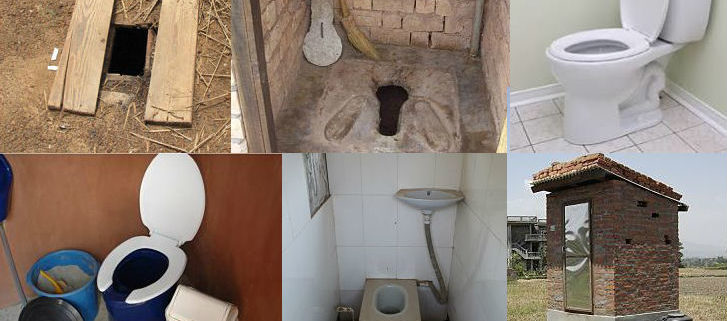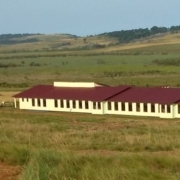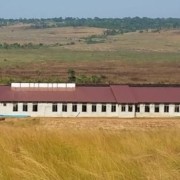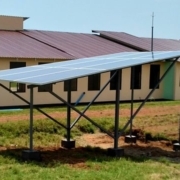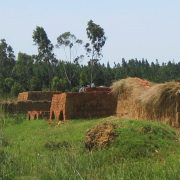In search of the perfect toilet
We’ve been spending lots of time in the past few months thinking about toilets. Here in the US where we just “flush and forget” it’s easy to overlook sanitation as an important issue, but it’s a big issue in places like sub-Saharan Africa, where only 30% of the population has access to improved sanitation. “Improved” sanitation means a toilet which protects the user from contact with feces. It includes anything from a pit toilet with a slab to a western flush toilet. We’ve been learning a lot about the challenges of sanitation as we look for an environmentally friendly toilet for Twegashe School. In this post we’ll share some of the possibilities we’ve been considering.
Double vault urine-diverting dehydration toilet
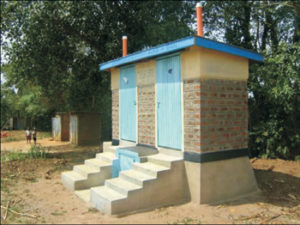
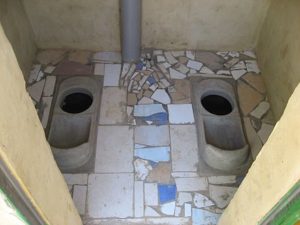 This “double vault urine-diverting dehydration toilet” (UDDT) uses no water. The toilet separates urine and feces at the user interface. The liquid is diverted to storage tanks for possible use as a fertilizer, or into a soak-away pit. One side of the toilet is used for about six months and then closed. The feces is allowed to dry while the second vault is being used. Once dried, it is easily removed through the door at the back of the vault. Because the fecal material is kept dry, problems with odors and flies are greatly reduced. Some drawbacks with these toilets are that they are more difficult to clean since no water can be allowed to get into the vault, and small children may have difficulty using them properly. Also, the dehydration process within the toilet vault does not kill all pathogens, so further treatment in a drying shed is needed before the material can be used on crops. The opportunity to use urine as fertilizer would be appealing, but we are concerned about odors and about local acceptance. The presence of urinary schistosomiasis in the Lake Victoria area is also a concern, since this pathogen would not be destroyed with typical urine storage times.
This “double vault urine-diverting dehydration toilet” (UDDT) uses no water. The toilet separates urine and feces at the user interface. The liquid is diverted to storage tanks for possible use as a fertilizer, or into a soak-away pit. One side of the toilet is used for about six months and then closed. The feces is allowed to dry while the second vault is being used. Once dried, it is easily removed through the door at the back of the vault. Because the fecal material is kept dry, problems with odors and flies are greatly reduced. Some drawbacks with these toilets are that they are more difficult to clean since no water can be allowed to get into the vault, and small children may have difficulty using them properly. Also, the dehydration process within the toilet vault does not kill all pathogens, so further treatment in a drying shed is needed before the material can be used on crops. The opportunity to use urine as fertilizer would be appealing, but we are concerned about odors and about local acceptance. The presence of urinary schistosomiasis in the Lake Victoria area is also a concern, since this pathogen would not be destroyed with typical urine storage times.
Biogas
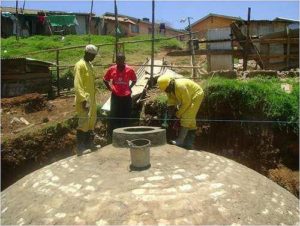 Another sanitation system alternative we’ve been looking at is biogas. At first glance, this looks like a beautiful solution—human waste undergoes anaerobic digestion, the gas produced is used for cooking, and the effluent that’s left over can be used on the garden. Solves the sanitation, cooking fuel, and fertilizer problems all at once! Unfortunately, it’s not quite that simple. The human digestive system is quite efficient, so in order to get a worthwhile amount of gas we would probably have to supplement with livestock manure. Also, determining whether the effluent would actually be safe for fertilizing crops has proved to be a challenge, since this depends on the exact type of system, on the climate, and on the type of pathogens that might be present. We’ve been in touch with several organizations working on providing biogas sanitation systems for schools in East Africa, but haven’t been able to get clear answers to our questions about the safety and feasibility of such a system for our school. As a result, we’re leaning away from biogas as a sanitation solution. But we’re designing the school layout so that it could accommodate a system for producing biogas from livestock waste. This will allow us to eventually use biogas for cooking in the school kitchen. That will be a project for a bit further down the road, if our agriculture program grows to the point that we decide to include livestock as well as crops.
Another sanitation system alternative we’ve been looking at is biogas. At first glance, this looks like a beautiful solution—human waste undergoes anaerobic digestion, the gas produced is used for cooking, and the effluent that’s left over can be used on the garden. Solves the sanitation, cooking fuel, and fertilizer problems all at once! Unfortunately, it’s not quite that simple. The human digestive system is quite efficient, so in order to get a worthwhile amount of gas we would probably have to supplement with livestock manure. Also, determining whether the effluent would actually be safe for fertilizing crops has proved to be a challenge, since this depends on the exact type of system, on the climate, and on the type of pathogens that might be present. We’ve been in touch with several organizations working on providing biogas sanitation systems for schools in East Africa, but haven’t been able to get clear answers to our questions about the safety and feasibility of such a system for our school. As a result, we’re leaning away from biogas as a sanitation solution. But we’re designing the school layout so that it could accommodate a system for producing biogas from livestock waste. This will allow us to eventually use biogas for cooking in the school kitchen. That will be a project for a bit further down the road, if our agriculture program grows to the point that we decide to include livestock as well as crops.
Composting toilet
A composting toilet uses natural soil organisms to convert excrement into a humus-like material that can be safely discarded or used as a garden fertilizer. No water for flushing is required. The safety of the resulting compost depends on the exact conditions, including the temperature, carbon content, moisture, aeration, and length of time of composting. “High-tech” composting toilets like the Clivus Multrum are designed to create exactly the right conditions to produce a safe end-product. But such systems are far too expensive to be practical in the developing world. We looked at a variety of simpler, more economical designs, but these toilets all require some sort of secondary composting to effectively remove pathogens. Incompletely composted waste material would need to be removed from the toilet chamber and transported to another location for further treatment. Our concern is that it would be difficult in the village setting to find someone willing to do this type of work. Another difficulty with composting toilets is the need to add high-carbon bulking material such as rice husks, vegetable scraps, or sawdust to aid the composting process. This would not be much of an obstacle in a household situation, but we expect that the school might have problems locating enough bulking material.
Microflush biofil toilet
All our searching and researching about toilets finally paid off when we discovered a variation of the composting toilet called the “microflush biofil toilet.” This toilet appears to be a safe and environmentally friendly sanitation solution. The toilet uses a specially-designed valve that flushes with as little as a cup of water, recycled from the hand-washing of the previous user. The valve isolates the waste from human contact, eliminating odors and flies. Common worms are used to digest the feces. Remarkably, they can reduce 126 grams of solid waste to only about 5 grams of pathogen-free compost in less than two weeks. The toilet can operate at 20 uses per day for two to three years before the toilet vault is emptied. When it is emptied, the product is compost that can safely be used on the garden. Only a small soakpit is required for liquid waste, since only a small amount of water is used.
The Ghana Sustainable Aid Project which is promoting these toilets operates on a model in which they train local “makers” of the toilets, who are then encouraged to establish a small business providing toilets to their community. We are planning to have our builder trained so that he can then train a maker in Bushasha Village. Our hope is that once villagers have seen these toilets in action at Twegashe School they may want to install one at their own home rather than using simple pit toilets which are the norm in the village right now.

